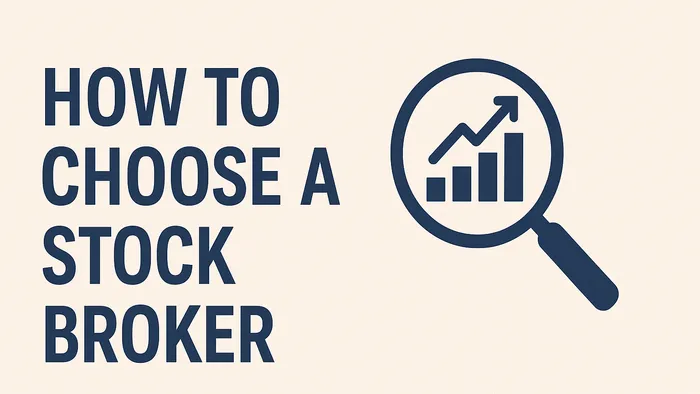Learn how to select the right stock broker by evaluating your trading needs, costs, platform features, support, and security measures.
Choosing the right stock broker is critical for your trading success. Here's what you need to focus on:
-
Understand Your Trading Needs
- Identify your trading frequency, style, and preferred investments (e.g., stocks, ETFs, options).
- Beginners need user-friendly platforms; advanced traders may require complex tools.
-
Compare Costs and Fees
- Look for trading fees, account maintenance, inactivity charges, and platform costs.
- Match the fee structure to your trading habits.
-
Evaluate Platform Features
- Prioritize ease of use, fast execution, and essential tools like charting and research.
- Check for mobile access and customization options.
-
Check Support and Education
- Assess customer service response times and educational resources like webinars or tutorials.
- Top brokers offer tools for all skill levels.
- Ensure Security and Compliance
Quick Comparison Table
| Criteria | Beginner Focus | Advanced Trader Focus |
|---|---|---|
| Trading Needs | Easy-to-use platforms, education | Real-time data, advanced tools |
| Fees | Low-cost, no hidden charges | Fee structures for frequent trades |
| Platform Features | Demo accounts, simple tools | Customization, analytics |
| Support | 24/7 help, learning resources | Dedicated account managers |
| Security | SIPC insurance, encryption | Same, with added fraud detection |
Top 11 Tips for Choosing the Best Stockbroker in 2025
1. Know Your Trading Requirements
Before choosing a broker, think about what you need for trading. Your trading habits, how often you trade, and the types of investments you prefer will help you figure out which broker services and features suit you best.
1.1 Trading Frequency and Style
How often and how you trade will shape the kind of tools you’ll need. For example, day traders rely on real-time data, quick execution, advanced charting tools, and extended-hours trading. It's worth noting that FINRA advises against day trading with accounts under $50,000, as smaller accounts may struggle to generate consistent profits.
1.2 Investment Types
The assets you plan to trade also play a big role in choosing a broker. Here’s a quick breakdown of what to look for based on your investment focus:
| Investment Type | Key Features to Look For |
|---|---|
| Stocks | Access to real-time quotes and research tools |
| ETFs | Commission-free trading options and research resources |
| Options | Tools for risk analysis and margin calculations |
| Mutual Funds | Fund screening tools and access to no-load funds |
1.3 Skill Level Considerations
Your experience level matters too. Beginners should prioritize user-friendly platforms, educational materials, and demo accounts to practice. On the other hand, experienced traders might need advanced analytics, custom indicators, and complex order types. Instead of focusing solely on profits, aim to develop consistent trading habits and avoid letting emotions drive your decisions.
Once you’ve outlined these needs, the next step is to evaluate broker fees to ensure their pricing works with your trading approach.
2. Understanding Broker Costs
Broker fees can eat into your trading profits, so it’s important to understand the different types of costs and weigh them against the value they bring.
2.1 Types of Broker Fees
Brokerage fees go beyond just trading commissions. Here are some common fees you might encounter:
| Fee Type | Typical Cost | Description |
|---|---|---|
| Annual Maintenance | $50-$75 | A fixed yearly charge, regardless of account activity. |
| Inactivity | $50-$200 annually | Applied if your account doesn't meet minimum trading requirements. |
| Research/Data | $1-$30 monthly | Optional subscriptions for advanced market insights. |
| Platform Usage | $50-$200+ monthly | Charges for premium trading software access. |
| Account Transfer | $50-$75 per transfer | One-time fee for moving assets between brokers. |
2.2 Fee Structure Analysis
Different trading styles call for different fee structures. For example, active traders who make frequent, smaller trades might save money with a per-share pricing model (e.g., $0.005 per share) instead of flat-rate commissions.
"Reducing trading fees and trading costs is essential for maximizing profits and building a sustainable trading strategy." – TheLuxuryPlaybook.com
Here’s how fee structures align with different broker types:
- Full-service brokers: Typically charge 1-2% annually on managed assets.
- Discount brokers: Offer basic trading services with lower fees.
- Robo-advisors: Charge an average of 0.20-0.30% annually.
It’s crucial to balance these costs with the features and services offered by the broker.
2.3 Price vs. Features
When comparing fees to features, focus on these key areas:
-
Platform Capabilities
Tools like advanced charting, real-time data, and research resources can justify higher fees for active traders. -
Service Level
Full-service brokers typically charge 1-2% annually for personalized advice and portfolio management. -
Cost-Saving Tips
- Opt for electronic statements to avoid paper fees.
- Choose brokers that include premium research tools for free.
- Keep your account active to avoid inactivity fees.
- Take advantage of volume-based discounts if you trade frequently.
3. Trading Platform Capabilities
Once you've identified your trading needs, it's crucial to evaluate whether your platform can meet those demands effectively.
3.1 Platform Ease of Use
The design and usability of a trading platform significantly impact your trading experience. A user-friendly interface can streamline your workflow and improve performance. Here are some key features to consider:
| Feature | Purpose | Impact on Trading |
|---|---|---|
| Intuitive Navigation | Easy access to essential tools | Speeds up trade execution |
| Customizable Layout | Tailor the workspace to your needs | Enhances efficiency |
| Fast Order Execution | Reduces delays in placing trades | Limits potential slippage |
| Mobile Access | Enables trading anytime, anywhere | Keeps you connected to the market |
3.2 Technical Analysis Tools
A good trading platform should offer a mix of powerful analysis tools and an easy-to-use design. Look for these must-have features:
- Real-time charting with multiple timeframes
- Integration of custom indicators
- Advanced order types for flexibility
- Tools for recognizing patterns
- Volume analysis capabilities
For instance, LuxAlgo provides hundreds of free technical indicators in its Library and additional exclusive toolkits on TradingView. These resources assist traders in identifying patterns and analyzing trends, helping them make better decisions.
3.3 Market Research Tools
"Research is more than just comprehensive reports, it’s about methodical integration, actionable insights, and clear explanations that empower investors to make informed decisions."
When assessing research tools, prioritize features that provide both depth and clarity. Key elements include:
-
Economic Calendars
These help you stay informed about upcoming events that could influence the market, offering context and educational resources to understand their impact. -
Screening Tools
Platforms like Fidelity include advanced screeners, such as their February 2025 screener powered by Zacks Investment Research, which provides detailed strategy insights. -
Portfolio Analysis
Look for tools that allow you to:- Monitor portfolio performance against benchmarks
- Evaluate risk metrics
- Review sector allocations
- Generate detailed performance reports
"A successful trading platform isn't just about features, it's about creating an ecosystem for your traders that supports them throughout their journey. Proper and thoughtful design is how you do it." – Pavel Tseluyko, CEO and Founder of Merge
As highlighted by StockBrokers.com's 2025 review, leading platforms now blend advanced features with intuitive designs, making even complex tools accessible to traders at all levels. This naturally transitions into the importance of broker support and training options.
4. Support and Training Options
Having access to reliable support and training resources is crucial for making the most of your broker's tools and adapting to market changes.
4.1 Customer Service Quality
Good customer service can play a major role in successful trading. StockBrokers.com's February 2025 evaluation highlights how top brokers perform when it comes to service quality.
| Broker | Overall Score | Connection Time | Professionalism Score |
|---|---|---|---|
| Fidelity | 9.15/10 | Under 1 min | 9.0/10 |
| Charles Schwab | 9.08/10 | 1 min | 9.0/10 |
| SoFi Invest | 8.63/10 | 1-2 min | 8.4/10 |
| Merrill Edge | 8.44/10 | 1-2 min | 8.0/10 |
"Customer service can make or break your brokerage experience, especially when you need fast answers about trading tools, account options, or rollovers." – Jessica Inskip, Director of Investor Research at StockBrokers.com
When assessing a broker's support, consider factors like response times, the variety of support channels, local branch availability, and the expertise of their staff. Beyond quick responses, having access to strong learning resources can also help you grow as a trader.
4.2 Learning Resources
In addition to dependable customer support, educational tools can help traders sharpen their skills and understand the market better.
- Charles Schwab offers free live lessons through its Schwab Coaching program.
- E*TRADE provides a wide range of resources, including archived webinars, options boot camp training, and community forums for peer learning.
- Fidelity includes in-app investment lessons as part of its Youth Accounts, focusing on saving and investing basics.
- Merrill Edge gives traders access to premium research reports from respected sources like Morningstar, Lipper, MSCI, and CFRA.
These resources cater to traders at various levels, offering opportunities to deepen market knowledge and improve decision-making.
5. Safety and Regulation
When it comes to trading, choosing a broker that's both secure and compliant is essential to protecting your investments. Ensuring a broker adheres to strict regulations and implements robust security measures helps safeguard your gains.
5.1 Regulatory Status
In the U.S., two key organizations oversee stock brokers: the Securities and Exchange Commission (SEC) and the Financial Industry Regulatory Authority (FINRA). FINRA currently supervises over 624,000 brokers nationwide.
To confirm a broker’s legitimacy, follow these steps:
- Use FINRA’s BrokerCheck tool to review their registration status and disciplinary history.
- Verify SEC registration through the Investment Advisor Public Disclosure database.
- Check state securities regulator records for additional details.
"FINRA's mission is to protect investors and safeguard the integrity of our vibrant capital markets to ensure that everyone can invest with confidence." – FINRA
5.2 Account Protection
Top brokers implement multiple layers of protection to secure your funds and personal data. Here’s a breakdown of standard safety measures:
| Protection Measure | Description | Coverage |
|---|---|---|
| SIPC Insurance | Shields against broker insolvency | Up to $500,000 in securities, including $250,000 in cash |
| SEC Rule 15c3-3 | Ensures customer assets are kept separate | Applies to all customer funds |
| Digital Security | Encryption and two-factor authentication | Continuous monitoring |
"Our markets have dramatically evolved since the 1972 adoption of Rule 15c3-3, otherwise known as the Customer Protection Rule. I'm pleased to support this adoption because it helps protect customers and the Securities Investor Protection Corporation Fund, while promoting greater trust in the markets." – SEC Chair Gary Gensler
Additionally, leading brokers often provide:
- Advanced encryption and multi-factor authentication for secure online transactions
- Real-time fraud detection systems
- Automated logout features to prevent unauthorized access
- Regular security audits and software updates
In 2023, FINRA’s Insider Trading Detection Program showcased the impact of these measures, with over 450 referrals made to U.S. law enforcement and global regulators.
Conclusion: Choosing Your Broker
To find the right broker for your trading needs, consider these five crucial factors: trading style, investment options, platform tools, customer support, and security features.
Match the broker's offerings to your trading approach. For example, if you're an active trader, you'll benefit from fast execution speeds and advanced charting tools. On the other hand, long-term investors should prioritize brokers with comprehensive research resources.
These considerations play a major role in determining your trading performance and managing costs effectively. Technical indicators from LuxAlgo can also simplify market analysis, helping traders make informed decisions.
Finally, take advantage of paper trading to test the platform before committing your funds.
FAQs
What should I consider when choosing a stock broker that fits my trading needs?
To choose a stock broker that aligns with your trading needs, start by identifying your investment style (e.g., active trading vs. long-term investing) and your financial goals. Consider the types of accounts you want to open, such as individual, joint, or retirement accounts.
Evaluate key factors like the broker's fees and commission structure, the quality of their trading platform, and the tools they offer, such as research resources or charting capabilities. Make sure the broker is regulated by reputable U.S. authorities and offers reliable customer support.
Finally, think about any additional features that might enhance your experience, such as mobile app functionality, educational resources, or access to specific markets or securities. By aligning these factors with your goals, you can make a more informed decision.
How do broker fees affect my trading strategy, and how can I reduce these costs?
Broker fees can have a significant impact on your trading strategy by reducing your overall returns. These costs may include commissions, platform fees, and other charges. Understanding and managing these expenses is crucial to maximizing your profits.
To reduce fees, consider choosing a broker with a competitive or zero-commission fee structure that aligns with your trading style. For example, active traders should prioritize low transaction costs, while long-term investors may focus on avoiding account maintenance or inactivity fees. Additionally, high-volume traders may have the option to negotiate better rates. Always review the fine print to avoid unexpected charges, such as hidden fees or margin interest.
What security features should I prioritize when choosing a US stock broker to protect my investments?
When selecting a stock broker, prioritize robust security measures to safeguard your investments and personal information. Look for brokers that offer two-factor authentication (2FA) for account access, as this adds an extra layer of protection beyond your password. Ensure the broker uses encrypted, secure (https) website connections to protect data during online transactions.
Additionally, consider brokers that provide account monitoring tools to help you detect suspicious activity and recommend regularly reviewing your account statements for unauthorized transactions. Using up-to-date security software and enabling features like security tokens can further enhance your account’s safety. Taking these steps will help ensure your investments are well-protected.








